AUDI Q7 2010 Owner´s Manual
Manufacturer: AUDI, Model Year: 2010, Model line: Q7, Model: AUDI Q7 2010Pages: 390, PDF Size: 93.04 MB
Page 311 of 390

___________________________________________ C..:...._ h:....:e :....:c:..:. k.::..: i..:.. n .:..:g:!:....:: a....:. n..:.. d~ f:....:. i.:..ll :.:.i:....:n :.:g !....- __
Disconnecting the battery terminals
Some vehicle f unct ions (powe r window regula to rs, fo r ex am ple) are
lost if the batt ery t ermina ls are disconnec ted . These func tions hav e
to be re lea rne d after the battery term ina ls a re co nnecte d aga in . To
prev en t th is, t he battery should only b e disconn ecte d from th e
vehicle e lectr ica l system when absol ute ly necessary for repairs .
Vehicles not driven for long periods
If you do not drive your veh icle over a period of seve ra l days o r wee ks,
el ect rical compo nents are g radually cu t back or swi tched off . This
re duces ene rgy consumption an d maintains start in g ca pability ove r a
lo nger pe riod=>
pag e 259.
Take into consideration t hat when you unlock your vehicle, some
c onvenie nce func tions, such a s the m aster key remote function or
power seat ad justment , may not be ava ilab le. T he conven ience func
t ions wi ll be available again when you turn on the ignition and st art
t he engin e.
Winter operation
Dur ing the w inter months, batte ry capac ity tends to decrease as
t empe ra tures drop . This is beca use mo re powe r is also co nsu med
w hile starting, and the headlights, rear w indow defogger, etc ., are
used more often .
Avoid unnecessa ry power consu mptio n, part icularl y in city tra ffic o r
w hen trave ling on ly short distances . Let your author ized A udi deale r
ch eck t he capa city of the vehicle ba ttery before w inter sets in
=>
page 311. A well charged battery will not only prevent start ing
pro blems when the we ather is co ld, but wi ll a lso la st l onge r.
[ i J Tips
If you r ve hicl e is left s tandi ng for seve ral weeks at extremely low
tempe ratures, t he ve hicle battery should be removed and stored
w here it will no t free ze . T his will preven t it fr om being dam age d and
having to be replaced .•
Safety first
Working on the battery
B e es pec ially ca reful when workin g on o r nea r the
batt ery.
The battery is located un de r th e d rive r's se at . B efo re yo u
ch eck a nyth ing under the driv er's sea t,
read and heed all
WARNINGS =>& .
Always heed the safety warnings , when wo rking on the vehicle
battery or the ve hicle elect rical system to p reve nt injury .
The following WARNINGS are very important when
working on the battery:
Always heed the following WARNING SYMBOLS and safety pre
cautions when working on the battery.
@
Always wear eye protection.
Battery acid contains sulfuric acid. Always wear
gloves and eye protection.
No
- sparks
- flames
• smoking .
When a battery is charged, it produces hydrogen
gas which is explosive and could cause personal injury.
Always keep the battery well out of reach of chil
dren.
& WARNING
Whenever working on the battery or on the electrical system ,
there i s the risk of injury, accident and even fire. Read and heed
the following WARNINGS: .,_
Vehicle care Technical data
Page 312 of 390
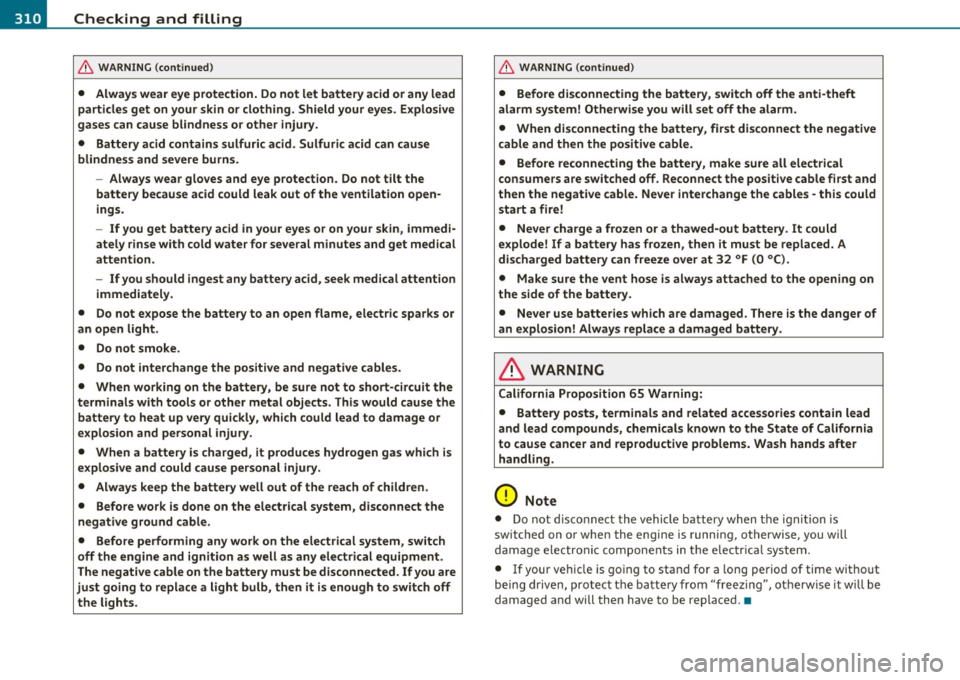
llft!I __ C_ h_ e_c _k _i _ n _g ~ a_n _d_ f_il _l_in _ g _________________________________________ _
& WARNING (conti nu ed )
• Always wear eye protection. Do not let battery acid or any lead
particles get on your skin or clothing. Shield your eyes. Explo sive
gases can cause blindness or other injury.
• Battery acid contains sulfuric acid. Sulfuric acid can cause
blindnes s and severe burns .
- Always wear gloves and eye protect ion. Do not tilt the
battery because acid could leak out of the ventilation open
ings.
- If you get battery acid in your eyes or on your skin , immedi
atel y rinse with cold water for several minutes and get medical
attention.
- If you should ingest any battery acid, seek medical attention
immediately.
• Do not expose the battery to an open flame, elect ric sparks or
an open light .
• Do not smoke.
• Do not int erchange the positive and negative cab les .
• When working on the battery, be sure not to short-cir cuit the
terminals with tools or other metal obje cts. This would cause the
battery to heat up very quickly, which could lead to damage or
explosion and per sonal injury .
• When a battery is charged , it produces hydrogen gas which i s
e xplosive and could cause personal injury.
• Always keep the battery well out of the reach of children .
• Before work is done on the electrical system, disconnect the
negative ground cable.
• Befo re performing any work on the electrical system , swit ch
off the engine and ignition as well as any electrical equipment .
The negative cable on the battery must be disconnected. If you are
ju st going to replace a light bulb, then it is enough to switch off
the l ights.
& W ARNING (continued )
• Before di sconnecting the battery , switch off the anti-theft
alarm system! Otherwise you w ill set off the alarm .
• When disconnecting the battery, first disconnect the negative
cable and then the po sitive cable .
• Before reconnecting the battery , make su re all electri cal
consumers are sw itched off . Reconnect the positive cable first and
then the negative cable. Never interchange the cables - this could start a fire!
• Never charge a frozen or a thawed-out battery. It could
e x plode! If a battery has frozen, then it must be replaced. A
di scharged battery can freeze o ver at 32 °F (0 °C ).
• Make sure the vent hose is always attached to the open ing on
the side of the battery .
• Never use batte ries which are damaged . There is the danger of
an explosion! Alway s repla ce a damaged battery .
& WARNING
California Proposition 65 Warning:
• Battery posts , terminals and related accessorie s contain lead
and lead compounds, chemicals known to the State of California
to cause cancer and reproductive problems. Wash hands after
handling.
0 Note
• Do not disco nne ct the vehi cle battery when t he ign it ion is
switched on o r when the engine is running, otherwise, you wi ll
da mage e le ctronic compone nts in t he e lec trica l system .
• If your ve hicle is go ing to stan d for a long period of time witho ut
bei ng d rive n, protect the ba tte ry from "freezing", ot herwis e it w ill be
damaged and will then have to be replaced.•
Page 313 of 390
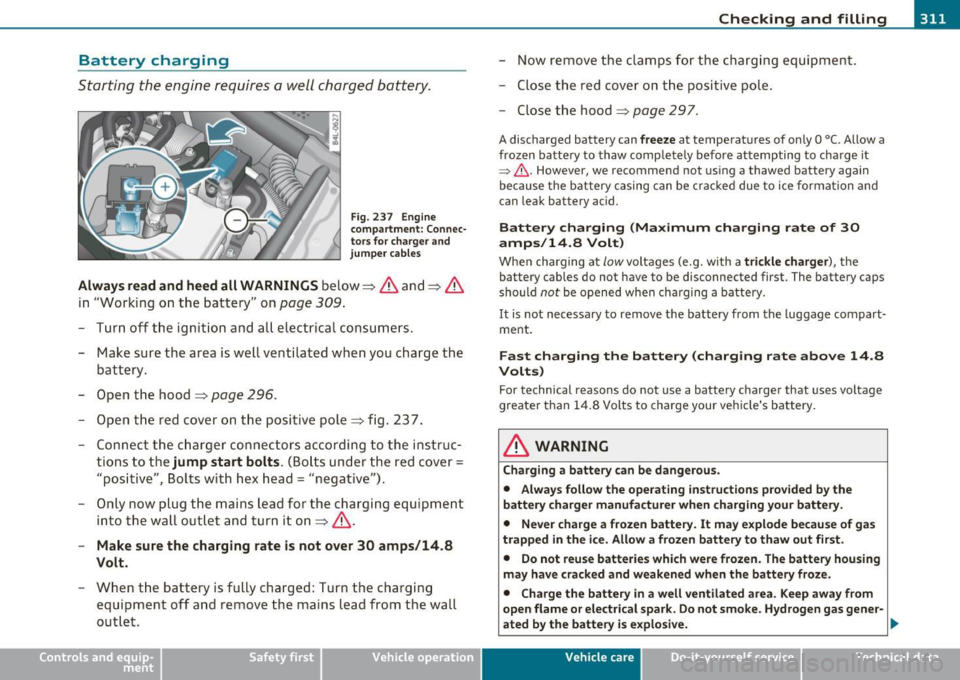
Checking and filling -
-------------------=------=:;______,.J,,...
Battery charging
Starting the engine requires a well charged battery.
Fig. 237 Engine
compa rtment : Connec
tor s for charger and
jumper cables
Always read and heed all WARNINGS below=> & and => &
in "Working on the battery" on
page 309.
- Turn off the ignition and all electrical consumers.
- Make sure the area is well ventilated when you charge the
battery.
- Open the hood :::::,
page 296.
-Open the red cover on the positive pole =>fig. 23 7.
- Connect the charger connectors according to the instruc-
tions to the
jump start bolts . (Bolts under the red cover=
"positive", Bolts with hex head
= "negative") .
- Only now plug the mains lead for the charging equipment
into the wall outlet and turn it on =>& .
-Make sure the charging rate is not over 30 amps/14.8
Volt.
- When the battery is fully charged: Turn the charging
equipment off and remove the mains lead from the wall
outlet.
Vehicle OP-eration
-Now remove the clamps for the charging equipment.
- Close the red cover on the positive pole.
- Close the hood :::::,
page 297.
A discharged battery can freeze at temperatures of only O 0C. Allow a
frozen battery to thaw completely before attempting to charge it
~ & .However, we recommend not using a thawed battery again
because the battery casing can be cracked due to ice formation and
can leak battery acid.
Battery charging (Maximum charging rate of 30
amps/14.8 Volt)
When charging at low voltages (e.g. with a trickle charger ), the
battery cables do not have to be disconnected first . The battery caps
sho uld
not be opened when charging a battery.
It is not necessary to remove the battery from the luggage com part·
ment.
Fast charging the battery (charging rate above 14.8
Volts)
For technical reasons do not use a battery charger that uses voltage
greater than 14.8 Volts to charge your vehicle's battery .
& WARNING
Charging a battery can be dangerous.
• Always follow the operating instructions provided by the
battery charger manufacturer when charging your battery.
• Never charge a frozen battery. It may explode because of gas
trapped in the ice. Allow a frozen battery to thaw out first.
• Do not reuse batteries which were frozen. The battery housing
may have cracked and weakened when the battery froze.
• Charge the battery
in a well ventilated area. Keep away from
open flame or electrical spark. Do not smoke. Hydrogen gas gener-
ated by the battery is explosive. •
Vehicle care Do-it-yourselt service Technical data
Page 314 of 390
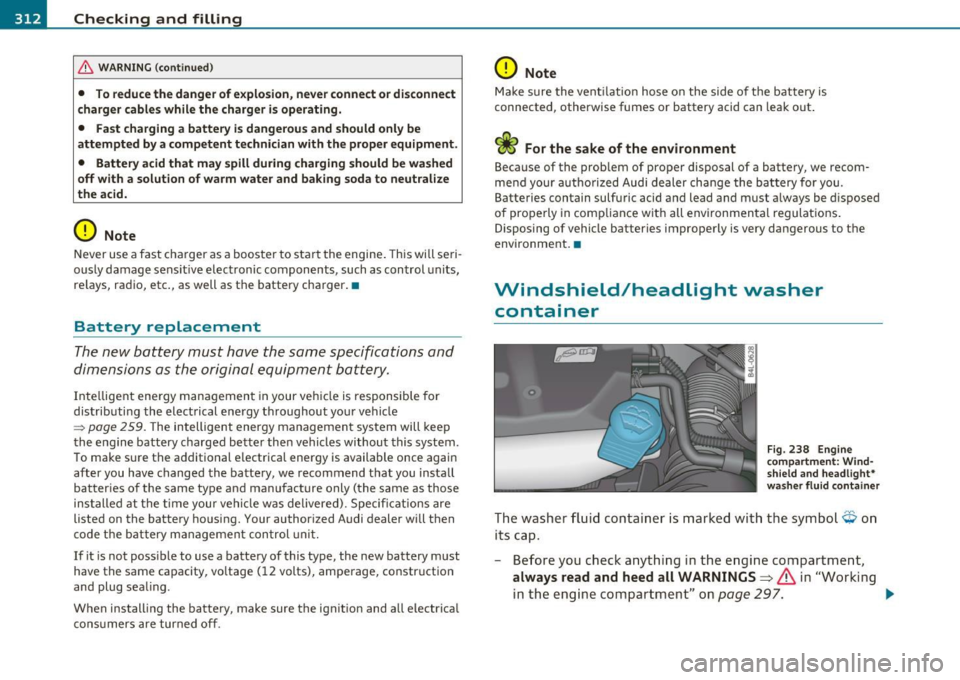
-Checking and filling .,,,, _ _..::::.__-=-----------------
& WARNING (continued)
• To reduce the danger of explosion, never connect or disconnect
charger cables while the charger is operating.
• Fast charging a battery is dangerous and should only be
attempted by a competent technician with the proper equipment.
• Battery acid that may spill during charging should be washed
off with a solution of warm water and baking soda to neutralize
the acid.
0 Note
Never use a fast charger as a booster to start the engine. This will seri
ously damage sens it ive electronic components, such as control units,
relays, radio, etc ., as well as the battery charger.•
Battery replacement
The new battery must have the same specifications and
dimensions as the original equipment battery.
Intelligent energy management in your veh icle is responsible for
distributing the electrical energy throughout your vehicle
~ page 259. T he intelligent energy management system will keep
the engine battery charged better then vehicles without this system .
To make sure the additional electrical energy is available once again
after you have changed the battery, we recommend that you install
batteries of the same type and manufacture only (the same as those
installed at the time your vehicle was delivered). Specifications are
listed on the battery housing. Your authorized Audi dealer will then
code the battery management control unit.
If it is not poss ible to use a battery of this type, the new battery must
have the same capacity, vo ltage (12 volts), amperage, construction
and plug sea ling .
When installing the battery, make sure the ignition and all electrica l
consumers are turned off.
0 Note
Make sure the vent ilation hose on the side of the battery is
connected, otherwise fumes or battery acid can leak out.
mend your authorized Audi dealer change the battery for you.
Batteries contain sulfuric acid and lead and must always be disposed
of properly in compliance with all environmental regulat ions.
Disposing of vehicle batteries improperly is very dangerous to the
environment. •
Windshield/headlight washer
container
Fig. 238 Engine
com partm ent : Wind·
shield and headlight"
wash er fluid container
The washer fluid container is marked with the symbol~ on
its cap.
- Before you check anything in the engine compartment,
always read and heed all WARNINGS~ & in "Working
in the engine compartment" on page
297. ..,_
Page 315 of 390
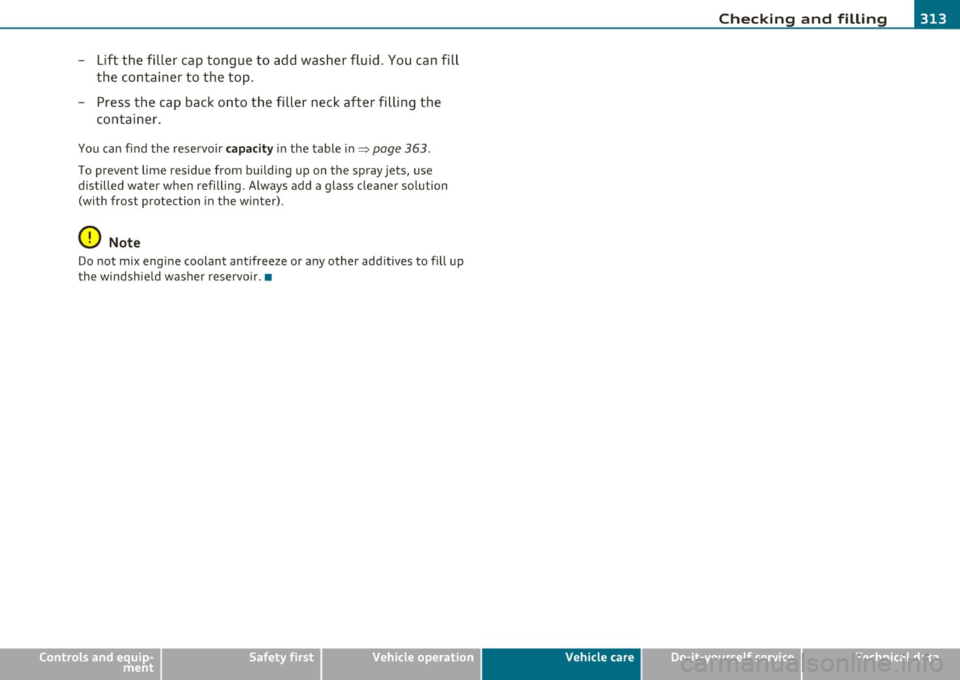
Checking and filling --------------~--EMI
- Lift the filler cap tongue to add washer fluid . You can fill
the container to the top .
- Press the cap back onto the filler neck after filling the container.
You can find the reservoir capacit y in the table in=:> page 363.
To prevent lime residue from bu ilding up on the spray jets, use
distilled water when refilling. Always add a g lass cleaner so lution
(with frost protection in the w inter) .
0 Note
Do not mix engine coolant antifreeze or any other additives to fill up
the windshie ld washer reservo ir .•
Safety first Vehicle care Technical data
Page 316 of 390
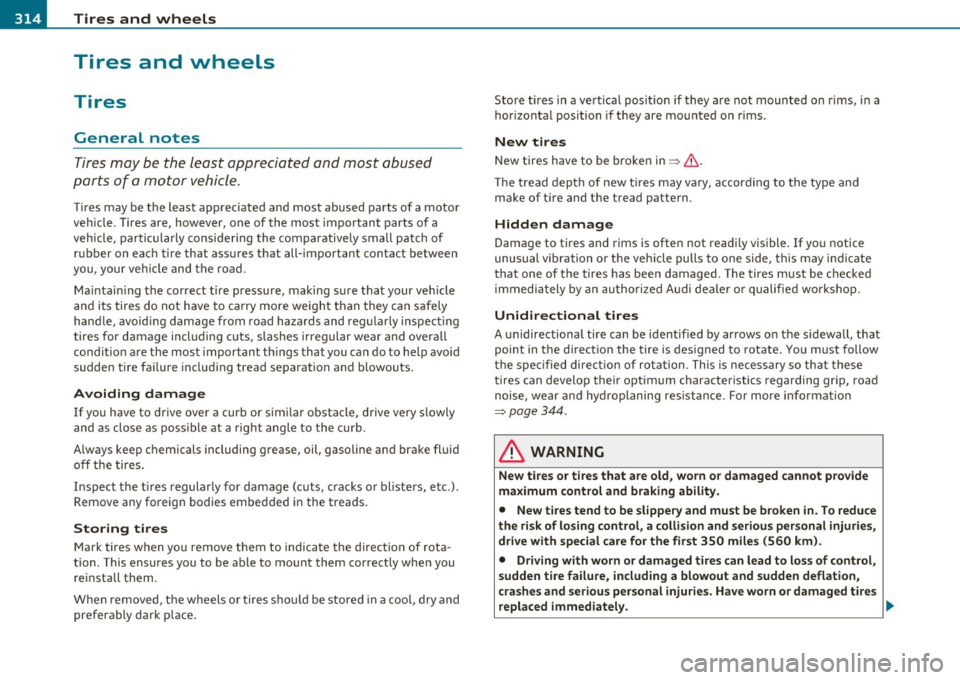
-~_T_ ir_e_ s_ a_ n_ d_ w_ h_e_ e_ ls _______________________________________________ _
Tires and wheels
Tires
General notes
Tires may be the least appreciated and most abused
parts of a motor vehicle.
T ir es may be the least apprec iated and most abused pa rts of a moto r
vehicle. Tires are, however, one of the most important parts of a
veh icle, parti cularly conside ring the comparative ly small patch of
rubber on eac h tire that assu res that all- important co ntact between
you , your ve hicle and the road .
Ma inta in ing t he correct t ire pressu re, making s ure that your veh icle
and i ts tires do not have to carry more weight than they can safely
hand le, avoid ing damage from road ha za rds and reg ula rly inspect ing
tires for damage incl ud ing c uts, s lashes irregular wea r and overall
condi tion are the mos t important th ings that you can do to help avoi d
sudden tire fa ilure includ ing t read separation and blowouts .
Avoiding damage
If you have to drive over a curb or sim ilar obstacle, drive very s lowly
and as close as poss ible at a right angle to the cu rb .
Always keep chemicals including grease, oil , gasoline and bra ke fl uid
o ff the t ires .
Inspect the ti res regularly for damage (cuts, crac ks o r bl ist ers, e tc .).
Remove any foreign bodies embed ded in the trea ds.
Storing tires
M ar k tires when yo u remove t hem to indica te the d irect ion of rota
tion . This ens ures yo u to be able to mo unt them co rrectly whe n you
re insta ll them.
Wh en r emoved, t he wheels or tires s hould be sto red in a c ool, dry and
preferably da rk p lace. Sto
re tires in a ver tica l pos it ion if they a re not mounted on rims, in a
hor izonta l position if they are mo unted on r ims.
New tires
N ew tires have to be bro ken in~ & .
Th e tread dep th of new tires may v ary, ac cor ding to t he type an d
make of t ire and the tread pattern.
Hidden damage
Dama ge to t ires and rims is often not readi ly visible . If yo u notice
unusu al v ib rat ion o r the veh icle pulls to one sid e, t his may i ndicate
that one of the tires has been damaged. The tires must be c hecke d
i m medi ately by an a uthor ized A udi deale r or quali fied w or ksh op .
Unidirectional tires
A u nidirectional tire can be identified by arrows on the sidewall, that
point in the d irect io n the tire is des igned to rotate. Yo u m ust follow
t he s peci fied dire ction of ro tation . T his is nece ssary so th at t hese
tires can develop the ir optimum c haracter istics regarding gr ip, road
noise, we ar and hy dropl aning res istance. For more informa tion
~page 344 .
& WARNING
New tires or tires that are old , worn or damaged cannot provide
maximum control and braking ability.
• New tires tend to be slippery and must be broken in. To reduce
the risk of losing control, a collision and serious personal injuries, drive with special care for the first 350 miles (560 km) .
• Driving with worn or damaged tires can lead to loss of control,
sudden tire failure , including a blowout and sudden deflation ,
crashes and serious personal injuries. Have worn or damaged tires
replaced immediately. .,_
Page 317 of 390
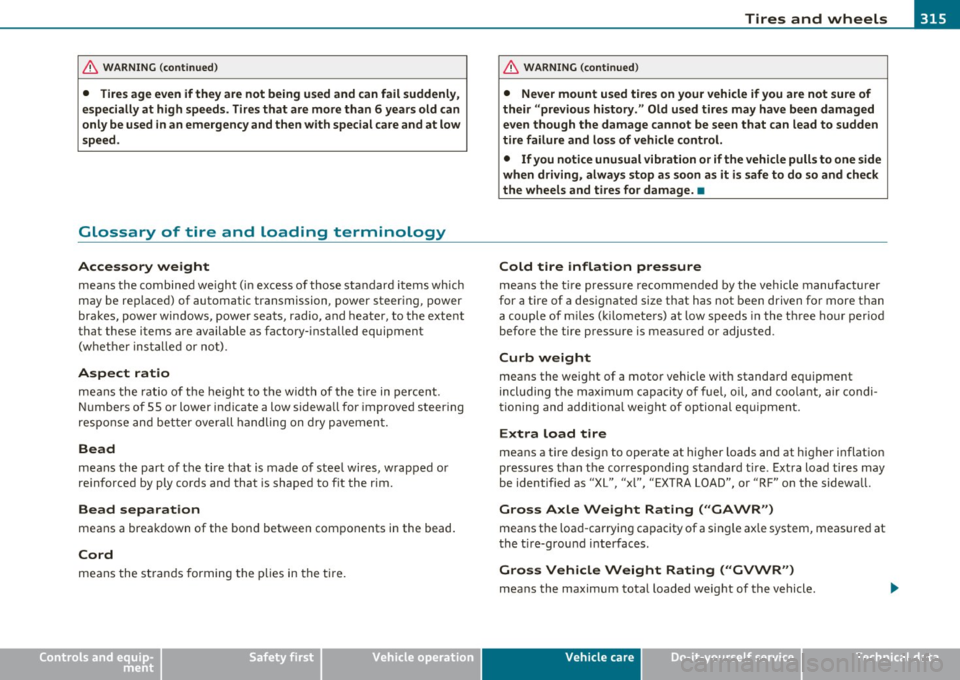
Tires and wheels -________________ fWII
& WARNING (co ntinued )
• Tires age even if they are not be ing used and can fail suddenly ,
e specially at high speeds . Tires that are more than 6 year s old can
only be used in an emergency and then with special care and at low
s peed .
Glossary of tire and loading terminology
Accessory weight
means the combined weigh t (in excess of those sta ndard items wh ich
may be replaced) of automatic transmission, power steer ing, power
bra kes, powe r win dows, power sea ts, radio, and heate r, to the exte nt
that these items are available as factory-insta lled equipment
(whet her i ns ta lled or no t).
Aspect ratio
means the r atio of t he he ight to t he widt h of the t ire in percent.
N umbers of 55 or lower indicate a low sidewa ll for improved steer ing
res ponse and bet ter over all h andling on dry p avemen t.
Bead
means the part of the t ire that is made of stee l wi res, w rapped or
re in forced by ply cords and that is shaped to fit the rim.
Bead separation
means a brea kdown of the bond between components in the bead.
Cord
means the st rands forming the plies in the ti re.
Safety first
& W ARNING (co ntinued )
• Never mount u sed tires on your vehicle if you are not sure of
their "previous history ." Old u sed tires may have been damaged
eventhoughthedamagecannotbeseenthatcanleadtosudden
tire failure and loss of vehicle control.
• If you notice unusual vibr ation or if the vehicle pulls to one side
when driving, always stop as soon as it is safe to do so and check
the wheels and tires for damage. •
Cold tire inflation pressure
means the t ire pressu re recom mended by the vehicle manufa ctu rer
for a tire of a desig nate d size that has not been driven for more than
a couple of m iles ( kilomete rs) a t low speeds in the t hree hour per io d
before the tire pressu re is measured or adjusted.
Curb weight
means the weight of a moto r vehicle wit h standard equipment
incl uding the max imum ca pac it y of fue l, o il, and coo lan t, air condi
tioning and additiona l weig ht of optional eq uipment.
Extra load tire
means a tire design to operate at higher loads and at higher inflat ion
pressures than t he co rresponding sta ndard t ire. Extra load tires may
be identif ied as "XL", "xl", "EXTRA LOAD", or "RF" on the sidewa ll.
Gross Axle Weight Rating ( "GAWR ")
means the loa d-carrying capac ity of a sing le ax le system, measure d at
the t ire-grou nd interfaces.
Gross Vehicle Weight Rating ("GVWR")
mea ns the maximum tota l loaded we ig ht of the vehicle .
Vehicle care Technical data
Page 318 of 390
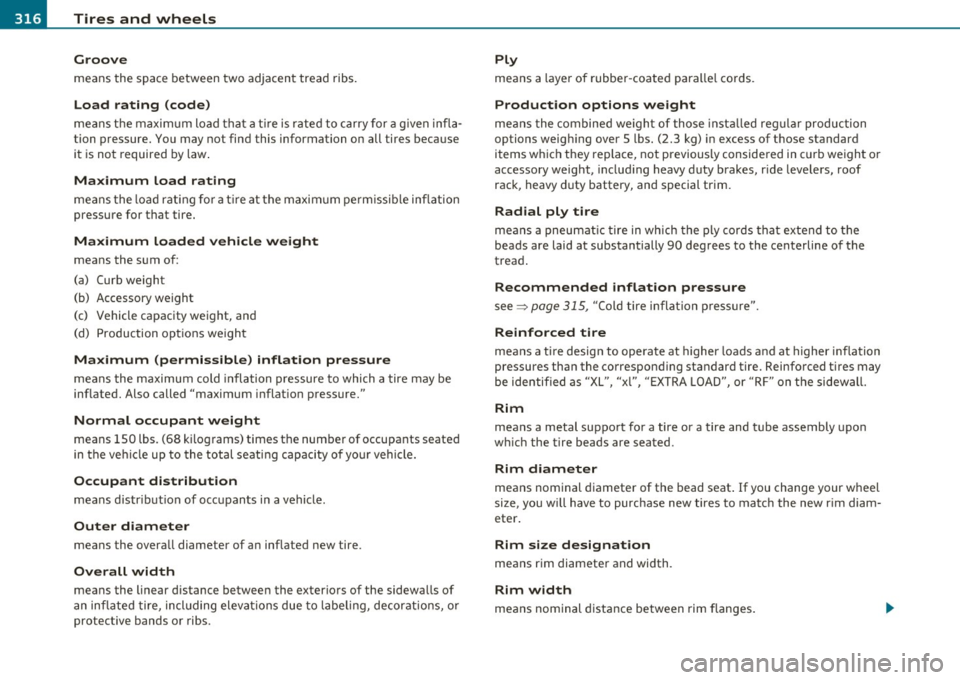
-~_T_ ir_e_ s_ a_ n_ d_ w_ h_e_ e_ ls _______________________________________________ _
Groove
means the space between two adjacent tread ribs.
Load rating (code)
means the maximum load that a tire is rated to carry for a given infla
tion pressure. You may not find this information on all tires because
it is not required by law.
Maximum load rating
means the load rating fo r a tir e at the maximum permissible inflation
pressure for that tire.
Maximum loaded vehicle weight
means the sum of:
(a) Curb weight
(b) Accessory weight
(c) Vehicle capacity weight, and
(d) Production options weight
Maximum (permissible) inflation pressure
means the maximum cold inflation pressure to which a tire may be
inflated. Also called "maximum inflation pressure."
Normal occupant weight
means 150 lbs. (68 kilograms) times the number of occupants seated
in the vehicle up to the total seating capacity of your vehicle.
Occupant distribution
means distr ibution of occupants in a vehicle .
Outer diameter
means the overall diameter of an inflated new tire.
Overall width
means the linear distance between the exteriors of the sidewalls of
an inflated tire, including elevations due to labeling, decorations, or
protective bands or ribs.
Ply
means a layer of rubber -coated paralle l cords.
Production options weight
means the combined weight of those installed regular production
options weigh ing over 5 lbs. (2.3 kg) in excess of those standard
items which they replace, not previously considered in curb weight or
accessory weight, including heavy duty brakes, ride levelers, roof
rack, heavy duty battery, and special trim.
Radial ply tire
means a pneumatic tire in which the ply cords that extend to the
beads are laid at substantially 90 degrees to the centerline of the
tread .
Recommended inflation pressure
see=> page 315, "Cold tire inflation pressure".
Reinforced tire
means a tire design to operate at higher loads and at higher inflation
pressures than the corresponding standard tire. Reinforced t ires may
be identified as "XL ", "x l", "EXTRA LOAD", or "RF" on the sidewall.
Rim
means a metal support for a tire or a tire and tube assembly upon
wh ich the tire beads are seated .
Rim diameter
means nominal diameter of the bead seat . If you change your wheel
size, you w ill have to purchase new tires to match the new rim diam
eter .
Rim size designation
means rim diameter and width.
Rim width
means nom inal distance between rim flanges.
Page 319 of 390
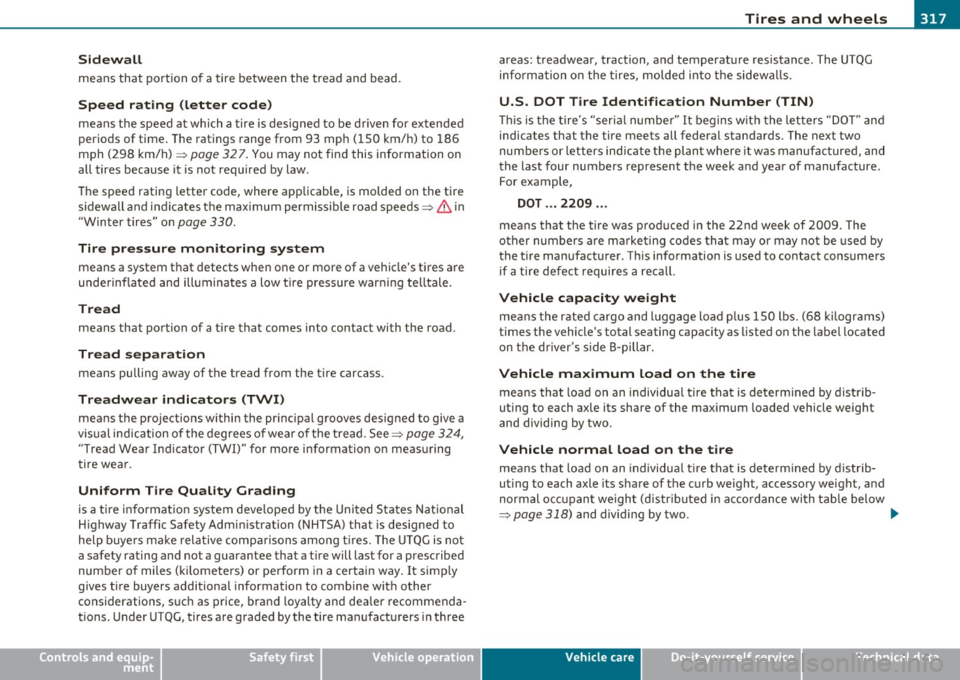
________________________________________________ T_i_re _ s_ a _ n_d_ w_ h_ e_ e_l_s __ nn
Sidewall
means that portion of a tire between the tread and bead.
Speed rating (letter code)
means the speed at which a tire is designed to be driven for extended
periods of time. The ratings range from 93 mph (150 km/h) to 186
mph (298 km/h)=>
page 32 7. You may not find this information on
all tires because it is not required by law .
The speed rating letter code, where applicable, is molded on the tire
sidewall and indicates the max imum permissible road speeds=>
& in
"Winter tires" on
page 330.
Tire pressure monitoring system
means a system that detects when one or more of a vehicle's tires are
underinflated and illuminates a low tire pressure warning telltale.
Tread
means that portion of a tire that comes into contact with the road.
Tread separation
means pulling away of the tread from the tire carcass .
Treadwear indicators (TWI)
means the projections within the principal grooves designed to give a
visual indication of the degrees of wear of the tread. See=>
page 324,
"Tread Wear Ind icator (TWI)" for more information on measuring
tire wear.
Uniform Tire Quality Grading
is a tir e information system developed by the United States National
Highway Traffic Safety Administration (NHTSA) that is designed to
help buyers make relative comparisons among tires. The UTQG is not
a safety rating and not a guarantee that a tire will last for a prescribed
number of miles (kilometers) or perform in a certain way. It simp ly
gives tire buyers additional information to combine with other
considerations, such as price, brand loyalty and dealer recommenda
tions. Under UTQG, tires are graded by the tire manufacturers in three
Safety first
areas: treadwear, traction, and temperature resistance . The UTQG
information on the tires, molded into the sidewalls.
U.S. DOT Tire Identification Number (TIN)
This is the tire's "serial number" It begins with the letters "DO T" and
indicates that the tire meets all federal standards. The next two
numbers or letters indicate the plant where it was manufac tured, and
the last four numbers represent the week and year of manufacture.
For example,
DOT ... 2209 ...
means that the tire was produced in the 22nd week of 2009 . The
other numbers are ma rket ing codes that may or may not be used by
the tire manufacturer . Th is information is used to contact consumers
if a tire defect requires a recall.
Vehicle capacity weight
means the rated cargo and luggage load plus 150 lbs. (68 kilograms)
times the vehicle's total seating capacity as listed on the label located
on the driver's side B-pillar.
Vehicle maximum load on the tire
means that load on an individua l tire that is determined by distrib
uting to each axle its share of the maximum loaded vehicle weight
and dividing by two.
Vehicle normal load on the tire
means that load on an individua l tire that is de term ined by distrib
uting to each axle its share of the curb weight, accessory weight, and
normal occ upant weight (distr ibuted in accordance with table below
=> page 318) and dividing by two. ..,_
Vehicle care Technical data
Page 320 of 390
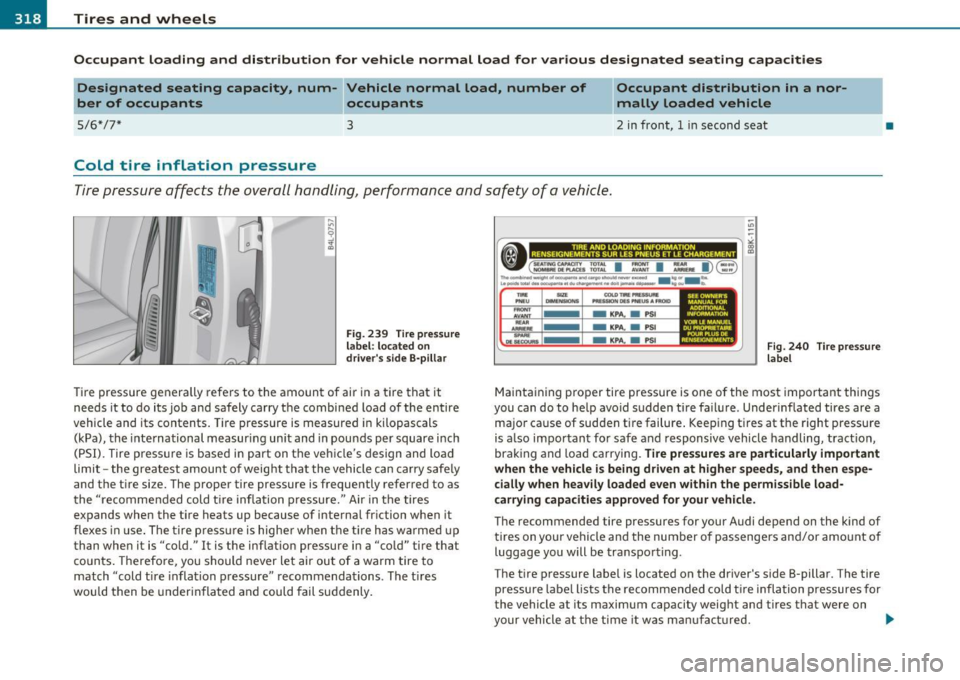
___ T_ i_ r _e _s_ a_n_ d_ w_ h_ e_e_ l_ s _______________________________________________ _
Occ up ant loading and distribution for vehi cle normal load for various d esignated seating capacit ies
Designated seating capacity, num- Vehicle normal load, number of Occupant distribution in a nor
mally loaded vehicle
ber of occupants occupants
5/6*/7*
3 2 in front, 1 in second seat
Cold tire inflation pressure
Tire pressure affects the overall handling, performance and safety of a vehicle .
Fig. 239 Tire pre ssure
la bel: loc ate d on
d river 's si de B ·pillar
Tire pressure generally refers to the amount of air in a t ire that it
needs it to do its job and safely carry the combined load of the entire
vehicle and its contents . Tire pressure is measured in kilopascals
(kPa), the inte rnational measur ing un it and in pounds per square i nch
(PSI). Tire press ure is based in part on t he vehicle 's design and load
limit -the greatest amount of weight tha t the vehicle can carry safe ly
and the t ire si ze. The proper tire pressure is frequently referred to as
the "recommended cold t ire inflation pressure. " Air in t he tires
expands when the tire heats up because of internal friction when it
flexes in use . The tire p ress ure is highe r when the t ire has wa rmed up
than when it is "cold." It is the inflation pressure in a "cold" tire that c o unts . Therefo re, you should never let air ou t of a wa rm tire to
match "cold tire inflation pressure " recommendations . The t ires
wou ld then be underin flated and could fail suddenly .
SIZf COlD fflE PRESSUAf DIME NSION'S MfSSK)N DE$ l"NEV$ A fFIOiD
- KPA , . PSI
- KPA,. PSI
- KPA,. PSI
Fig. 240 Tir e pre ssure
label
Maintaining proper tire pressure is one of the most important things
you can do to he lp avoid sudden tire failure . Underinflated tires are a
ma jo r cause of sudden tire failure . Keep ing t ires at the right pressure
is a lso important fo r safe and responsive vehicle handling, t ract ion,
braking and load carrying.
Tire p ressures are particularl y important
when the vehicle i s being driven at higher speed s, and then e spe
cially when h eavily loaded even with in the permissible load
carrying capacitie s approved for your v ehicle .
The recommended tire pressures for your Audi depend on the kind o f
t ires on you r vehicle and the number o f passengers and/or amo unt of
luggage you will be transport ing .
The tire pressure label is located on the driver 's side 8-pillar . T he tire
pressure labe l lists the recommended cold t ire inflation p ressures for
the vehicle at its maximum capacity weig ht and tires that were on
•
your vehicle at the time it was m anufactured. .,